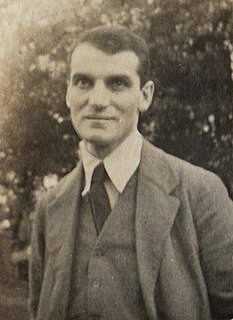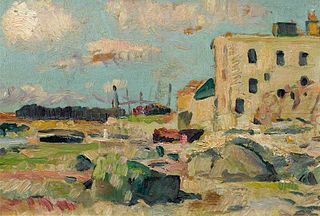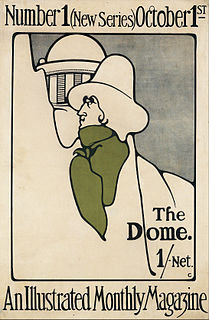
Rhythm (briefly known as The Blue Review) was a literary, arts, and critical review magazine published in London, England, from 1911 to 1913.

Rhythm (briefly known as The Blue Review) was a literary, arts, and critical review magazine published in London, England, from 1911 to 1913.
The first issue of Rhythm was a summer 1911 edition. It was a quarterly until after the Spring 1912 issue, when it began to publish monthly. The final issue under the name Rhythm was published in March 1913; in May 1913, the magazine resumed publication under the name The Blue Review. After publishing additional issues in June and July 1913, the magazine then ceased publication.
The magazine, sometimes referred to as a "little magazine", was focused primarily on literature, music, art, and theatre.
Throughout its history, the magazine was edited by John Middleton Murry, who co-founded it with Michael Sadleir. [1] Katherine Mansfield was the associate editor from June 1912 until the magazine folded. Its title was borrowed from a major painting of a female nude (a drawing of which appears on its front cover) by J. D. Fergusson who became its art editor. [2] The magazine went through three separate publishers: it began with St Catherine Press; when it became a monthly, it was published by Stephen Swift & Co. Under the name The Blue Review, it was published by Martin Secker.
The painter Anne Estelle Rice was one of its chief illustrators. [3]
According to arts historian Roger Neill:
The aesthetic concept of "rhythm" – harmony in nature, vigour and directness – provided the connective tissue, not only between two Scottish Colourists (Fergusson and Peploe, plus Rice), but also between the writers and artists involved with the magazine. [4]


Kathleen Mansfield Murry was a New Zealand writer, essayist and journalist, widely considered one of the most influential and important authors of the modernist movement. Her works are celebrated across the world, and have been published in 25 languages.

McClure's or McClure's Magazine (1893–1929) was an American illustrated monthly periodical popular at the turn of the 20th century. The magazine is credited with having started the tradition of muckraking journalism, and helped direct the moral compass of the day.

The Scottish Colourists were a group of four painters, three from Edinburgh, whose Post-Impressionist work, though not universally recognised initially, came to have a formative influence on contemporary Scottish art and culture. They four artists, Francis Cadell, John Duncan Fergusson, Leslie Hunter and Samuel Peploe, were prolific painters spanning the turn of the twentieth century until the beginnings of World War II. While now banded as one group with a collective achievement and a common sense of British identity, it is a misnomer to believe their artwork or their painterly careers were heterogeneous.

John Middleton Murry was an English writer. He was a prolific author, producing more than 60 books and thousands of essays and reviews on literature, social issues, politics, and religion during his lifetime. A prominent critic, Murry is best remembered for his association with Katherine Mansfield, whom he married in 1918 as her second husband, for his friendship with D. H. Lawrence and T. S. Eliot, and for his friendship with Frieda Lawrence. Following Mansfield's death, Murry edited her work.

Albert Gleizes was a French artist, theoretician, philosopher, a self-proclaimed founder of Cubism and an influence on the School of Paris. Albert Gleizes and Jean Metzinger wrote the first major treatise on Cubism, Du "Cubisme", 1912. Gleizes was a founding member of the Section d'Or group of artists. He was also a member of Der Sturm, and his many theoretical writings were originally most appreciated in Germany, where especially at the Bauhaus his ideas were given thoughtful consideration. Gleizes spent four crucial years in New York, and played an important role in making America aware of modern art. He was a member of the Society of Independent Artists, founder of the Ernest-Renan Association, and both a founder and participant in the Abbaye de Créteil. Gleizes exhibited regularly at Léonce Rosenberg's Galerie de l’Effort Moderne in Paris; he was also a founder, organizer and director of Abstraction-Création. From the mid-1920s to the late 1930s much of his energy went into writing, e.g., La Peinture et ses lois, Vers une conscience plastique: La Forme et l’histoire and Homocentrisme.

The Egoist was a London literary magazine published from 1914 to 1919, during which time it published important early modernist poetry and fiction. In its manifesto, it claimed to "recognise no taboos", and published a number of controversial works, such as parts of Ulysses. Today, it is considered "England's most important Modernist periodical."
The Little Review, an American literary magazine founded by Margaret Anderson in Chicago's historic Fine Arts Building, published literary and art work from 1914 to May 1929. With the help of Jane Heap and Ezra Pound, Anderson created a magazine that featured a wide variety of transatlantic modernists and cultivated many early examples of experimental writing and art. Many contributors were American, British, Irish, and French. In addition to publishing a variety of international literature, The Little Review printed early examples of surrealist artwork and Dadaism. The magazine's most well known work was the serialization of James Joyce's Ulysses.

John Duncan Fergusson was a Scottish artist and sculptor, regarded as one of the major artists of the Scottish Colourists school of painting.

The New Age was a British weekly magazine (1894–1938), inspired by Fabian socialism, and credited as a major influence on literature and the arts during its heyday from 1907 to 1922, when it was edited by Alfred Richard Orage. It published work by many of the chief political commentators of the day, such as George Bernard Shaw, H. G. Wells, Hilaire Belloc, G. K. Chesterton and Arnold Bennett.
The New Freewoman was a monthly London literary magazine edited by Dora Marsden and owned by Harriet Shaw Weaver. Initially, Rebecca West was in charge of the literary content of the magazine, but after meeting Ezra Pound at one of Violet Hunt's parties in 1913 she recommended that he be appointed literary editor. The magazine existed between June 1913 and December 1913.

George Leslie Hunter was a Scottish painter, regarded as one of the four artists of the Scottish Colourists group of painters. Christened simply George Hunter, he adopted the name Leslie in San Francisco, and Leslie Hunter became his professional name. Showing an aptitude for drawing at an early age, he was largely self-taught, receiving only elementary painting lessons from a family acquaintance. He spent fourteen years from the age of fifteen in the US, mainly in California. Hunter made an extended trip to Scotland, Paris and New York from 1903-1905. In 1906 he left San Francisco and returned to Scotland, painting and drawing there, notably in Fife and at Loch Lomond. Subsequently he travelled widely in Europe, especially in the South of France, but also in the Netherlands, the Pas de Calais and Italy. He also returned to New York in 1924 and 1928-1929.

Scribner's Magazine was an American periodical published by the publishing house of Charles Scribner's Sons from January 1887 to May 1939. Scribner's Magazine was the second magazine out of the Scribner's firm, after the publication of Scribner's Monthly. Charles Scribner's Sons spent over $500,000 setting up the magazine, to compete with the already successful Harper's Monthly and The Atlantic Monthly. Scribner's Magazine was launched in 1887, and was the first of any magazine to introduce color illustrations. The magazine ceased publication in 1939.
The Modernist Journals Project (MJP) was created in 1995 at Brown University in order to create a database of digitized periodicals connected with the period loosely associated with modernism. The University of Tulsa joined in 2003. The MJP's website states:
The Modernist Journals Project is a multi-faceted project that aims to be a major resource for the study of modernism and its rise in the English-speaking world, with periodical literature as its central concern. The historical scope of the project has a chronological range of 1890 to 1922, and a geographical range that extends to wherever English language periodicals were published. With magazines at its core, the MJP also offers a range of genres that extends to the digital publication of books directly connected to modernist periodicals and other supporting materials for periodical study.
We end at 1922 for both intellectual and practical reasons. The practical reason is that copyright becomes an issue with publications from 1923 onward. The intellectual reason is that most scholars consider modernism to be fully fledged in 1922, a date marked by the publication of James Joyce's Ulysses, Virginia Woolf’s Jacob’s Room, and T. S. Eliot's The Waste Land. We believe the materials on the MJP website will show how essential magazines were to modernism's rise.

The Dome, subtitled consecutively "A Quarterly Containing Examples of All the Arts" and "An Illustrated Monthly Magazine and Review", was a literary periodical associated with the "Nineties" scene, edited by Ernest J. Oldmeadow, publisher and manager of The Unicorn Press based in London at 7 Cecil Court. It ran for three years, from March 1897 to July 1900. It is usually considered to be the last more or less successful attempt to deliver a valuable literary magazine with a considerable circulation, yet working from an Aestheticist rationale, according to Walter Pater's concepts.

Beatrice Hastings was the pen name of Emily Alice Haigh an English writer, literary critic, poet and theosophist. Her work was integral to British Magazine The New Age which she helped edit along with her lover, A. R. Orage, prior to the outbreak of the First World War. Hastings was also friend and lover of Katherine Mansfield, whose work was first published in The New Age. She also had love affairs with Wyndham Lewis and Amedeo Modigliani.
The Seven Arts, an early example of the Little Magazine, was edited by James Oppenheim, Waldo Frank, and Van Wyck Brooks; it appeared monthly from November 1916 through October 1917. Jointly envisaged by Oppenheim and Frank, The Seven Arts was an attempt to anticipate and influence the United States' emerging “renascent period;” in the first issue the editors explain: “In short, The Seven Arts is not a magazine for artists, but an expression of artists for the community.” Of the many contributors to the magazine, Sherwood Anderson, J. D. Beresford, Randolph Bourne, Theodore Dreiser, Robert Frost, Kahlil Gibran, D. H. Lawrence, Amy Lowell, Paul Rosenfeld, and Louis Untermeyer were among the most prolific.

The English Review was an English-language literary magazine published in London from 1908 to 1937. At its peak, the journal published some of the leading writers of its day.
Voices was a monthly literary magazine published in England from 1919 to 1921. Under the editorship of Thomas Moult, Voices tried to create a new readership for poetry among the young generation awaiting demobilization or returning from the war".
Anne Estelle Rice (1877–1959) was an American artist who was one of the chief illustrators for the British periodical Rhythm, edited by John Middleton Murry and Michael Sadleir from 1911 to 1913. She established a close relationship with Katherine Mansfield, and famously painted her wearing red.

Art in modern Scotland includes all aspects of the visual arts in the country since the beginning of the twentieth century. In the early twentieth century, the art scene was dominated by the work of the members of the Glasgow School known as the Four, led Charles Rennie Mackintosh, who gained an international reputation for their combination of Celtic revival, Art and Crafts and Art Nouveau. They were followed by the Scottish Colourists and the Edinburgh School. There was a growing interest in forms of Modernism, with William Johnstone helping to develop the concept of a Scottish Renaissance. In the post-war period, major artists, including John Bellany and Alexander Moffat, pursued a strand of "Scottish realism". Moffat's influence can be seen in the work of the "new Glasgow Boys" from the late twentieth century. In the twenty-first century Scotland has continued to produce influential artists such as Douglas Gordon and Susan Philipsz.